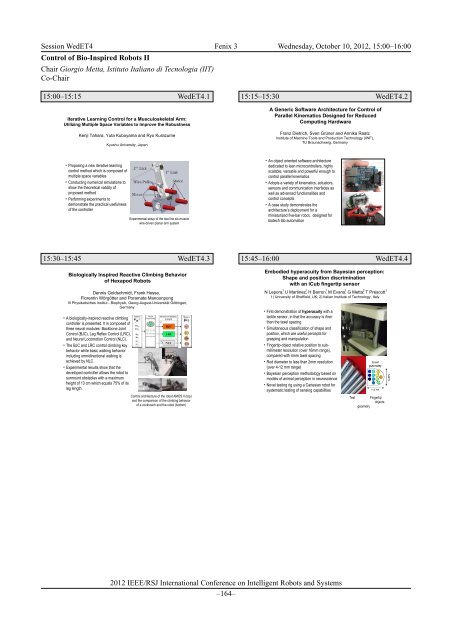Session WedAT1 Pegaso A Wednesday, October 10, 2012 ... - Lirmm
Session WedAT1 Pegaso A Wednesday, October 10, 2012 ... - Lirmm
Session WedAT1 Pegaso A Wednesday, October 10, 2012 ... - Lirmm
- TAGS
- pegaso
- october
- lirmm
- www2.lirmm.fr
You also want an ePaper? Increase the reach of your titles
YUMPU automatically turns print PDFs into web optimized ePapers that Google loves.
<strong>Session</strong> WedET4 Fenix 3 <strong>Wednesday</strong>, <strong>October</strong> <strong>10</strong>, <strong>2012</strong>, 15:00–16:00<br />
Control of Bio-Inspired Robots II<br />
Chair Giorgio Metta, Istituto Italiano di Tecnologia (IIT)<br />
Co-Chair<br />
15:00–15:15 WedET4.1<br />
Iterative Learning Control for a Musculoskeletal Arm:<br />
Utilizing Multiple Space Variables to Improve the Robustness<br />
Kenji Tahara, Yuta Kuboyama and Ryo Kurazume<br />
Kyushu University, Japan<br />
• Proposing a new iterative learning<br />
control method which is composed of<br />
multiple space variables<br />
• Conducting numerical simulations to<br />
show the theoretical validity of<br />
proposed method<br />
• Performing experiments to<br />
demonstrate the practical usefulness<br />
of the controller<br />
Experimental setup of the two-link six-muscle<br />
wire-driven planar arm system<br />
15:30–15:45 WedET4.3<br />
Biologically Inspired Reactive Climbing Behavior<br />
of Hexapod Robots<br />
Dennis Goldschmidt, Frank Hesse,<br />
Florentin Wörgötter and Poramate Manoonpong<br />
III Physikalisches Institut - Biophysik, Georg-August-Universität Göttingen,<br />
Germany<br />
• A biologically-inspired reactive climbing<br />
controller is presented. It is composed of<br />
three neural modules: Backbone Joint<br />
Control (BJC), Leg Reflex Control (LRC),<br />
and Neural Locomotion Control (NLC).<br />
• The BJC and LRC control climbing key<br />
behavior while basic walking behavior<br />
including omnidirectional walking is<br />
achieved by NLC.<br />
• Experimental results show that the<br />
developed controller allows the robot to<br />
surmount obstacles with a maximum<br />
height of 13 cm which equals 75% of its<br />
leg length.<br />
Control architecture of the robot AMOS II (top)<br />
and the comparison of the climbing behavior<br />
of a cockroach and the robot (bottom)<br />
15:15–15:30 WedET4.2<br />
A Generic Software Architecture for Control of<br />
Parallel Kinematics Designed for Reduced<br />
Computing Hardware<br />
Franz Dietrich, Sven Grüner and Annika Raatz<br />
Institute of Machine Tools and Production Technology (IWF),<br />
TU Braunschweig, Germany<br />
• An object oriented software architecture<br />
dedicated to lean microcontrollers, highly<br />
scalable, versatile and powerful enough to<br />
control parallel kinematics<br />
• Adopts a variety of kinematics, actuators,<br />
sensors and communication interfaces as<br />
well as advanced functionalities and<br />
control concepts<br />
• A case study demonstrates the<br />
architecture’s deployment for a<br />
miniaturized five-bar robot, designed for<br />
biotech lab automation<br />
15:45–16:00 WedET4.4<br />
Embodied hyperacuity from Bayesian perception:<br />
Shape and position discrimination<br />
with an iCub fingertip sensor<br />
1 1 1 1<br />
2<br />
1<br />
N Lepora, U Martinez, H Barron, M Evans, G Metta, T Prescott<br />
1) University of Sheffield, UK; 2) Italian Institute of Technology, Italy<br />
• First demonstration of hyperacuity with a<br />
tactile sensor, in that the accuracy is finer<br />
than the taxel spacing<br />
• Simultaneous classification of shape and<br />
position, which are useful percepts for<br />
grasping and manipulation<br />
• Fingertip-object relative position to submillimeter<br />
resolution (over 16mm range),<br />
compared with 4mm taxel spacing<br />
• Rod diameter to less than 2mm resolution<br />
(over 4-12 mm range)<br />
• Bayesian perception methodology based on<br />
models of animal perception in neuroscience<br />
• Novel testing rig using a Cartesian robot for<br />
systematic testing of sensing capabilities<br />
<strong>2012</strong> IEEE/RSJ International Conference on Intelligent Robots and Systems<br />
–164–<br />
Test Fingertip<br />
. objects<br />
geometry

















